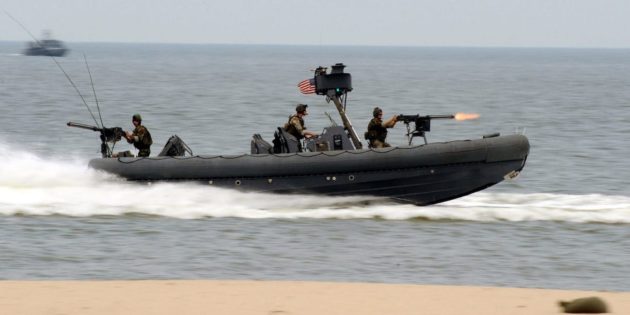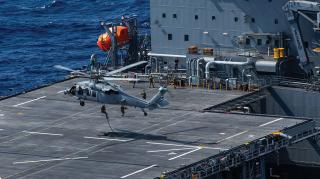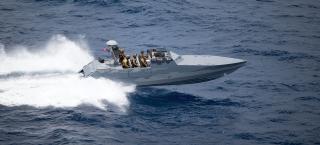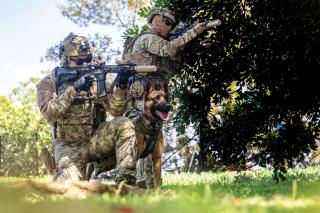Sponsored by NPS Foundation and the Naval Institute
Naval Special Warfare can contribute much to the fight at sea.
Since its first publication in 1986, the three editions of Captain Wayne Hughes’ Fleet Tactics and Naval Operations have become the definitive works on modern naval tactics in cyber, littoral, and fleet engagements. Despite the notable absence of Naval Special Warfare (NSW) from the text, NSW’s capabilities can support Hughes’ and coauthor Rear Admiral Robert Girrier’s six fleet functions: scouting and antiscouting; command and control (C2) and command-and-control countermeasures (C2CM); and firepower and counterforce.1 Fleet Tactics describes best practices for winning individual battles; NSW can directly contribute to naval victory in combat, especially in the littorals.2 Indeed, special forces contributions are most applicable within these confined coastal spaces crowded by commercial and military traffic—or, as Fleet Tactics puts it, “where the clutter is.”3
Fleet Engagements and Special Operations
The exclusion of special operations may result from the book’s heavy emphasis on missile warfare. Or perhaps it is because of the text’s assumptions that the purpose of naval operations, especially in littoral zones, is to support objectives on land.4 Special forces do not obviously fit into missile combat, and it is easy to assume any fleet effort that requires significant land forces would involve massed Marines or soldiers, eliminating the need for small units. It is an easy omission to make. Even retired Admiral William McRaven, perhaps the most notable contemporary scholar on special operations, sees special forces as small units capable of achieving victory over superior numbers through “relative superiority,” not as a component of a larger naval engagement.5
However, McRaven cites examples of special forces in littoral combat, such as the Italian manned torpedo attack at Alexandria in 1941 and the British attack on the battleship Tirpitz in 1943, which demonstrate a definite role for small units in naval tactics. These methods may simply need to be updated for 21st-century combat.6 NSW has proven itself capable of McRaven’s version of special operations, but it has much to contribute to national defense through support of the larger Navy.
SOF Supporting the Six Fleet Functions
NSW comprises theater-deployed forces that are manned, trained, and equipped by Naval Special Warfare Command. Most military members are familiar with the SEAL teams, but NSW is also home to special reconnaissance teams, special boat teams, and SEAL delivery vehicle teams. These NSW components all have niche capabilities and deploy together in various configurations based on the operating area. Most common is the “task unit,” which is an O-4-led formation containing boat detachments, special reconnaissance capabilities, and SEAL platoons, supported by a small headquarters and staff. This operational structure is adaptable and expeditionary and could support each of the six fleet tactical functions.
Hughes and Girrier note the potential of unmanned vehicles to address the challenges of scouting and antiscouting operations.7 Naval Special Warfare invested heavily in unmanned assets and associated tactics during the war on terror. As a result, NSW has a robust inventory of unmanned aerial systems and experts and has made significant progress in integrating unmanned underwater systems. These robotic platforms would make effective tools for littoral scouting and reconnaissance—as well as useful decoy and deception platforms—without risking human life or significant financial loss. The new expeditionary sea base (ESB) platform is designed to facilitate aviation and special operations forces, including launch and recovery of special operations craft, and to provide the most straightforward avenue to include NSW in naval operations. It would be well suited for deploying these expeditionary systems.8
The surface fleet is investing in developing unmanned systems, but it could be more expedient and cost-efficient in the near term to take advantage of NSW’s established capabilities rather than creating new programs from scratch. The flexible nature of special operations forces allows NSW to adjust quickly to new tactical requirements, test new ideas without disrupting existing fleet doctrine, and identify the resulting successful equipment and practices.9 Incorporating robotic platforms into scouting and antiscouting operations is a new construct for the fleet, but as Hughes and Girrier note, “The great constant of scouting seems to be that there is never enough of it.”10 It would be prudent to integrate NSW’s unmanned systems to add depth to the Navy’s scouting arsenal.
Hughes and Girrier assert that on land and sea, many “battles have been lost by abrupt degradation of control, followed by confusion and then fatal chaos.”11 NSW has a variety of tools it can bring to bear on what they describe as command and control and command-and-control countermeasures.12 A properly equipped SEAL element could cause chaos among enemy defense networks by targeting communication infrastructure or disrupting transportation. Naval special operations have their roots in near-shore scouting, and the sustained special reconnaissance mission has kept SEAL platoon skills sharp in covert inland patrolling and over-the-beach insertions.13 As Hughes and Girrier point out, in the age of missile warfare, “a substantial part of a coastal fleet may be land-based,” and it is reasonable to view land-based defenses as part of the naval engagement.14 SEALs could identify and mark targets, man forward observation posts, and perform battle damage assessments from within hostile territory. The combination of accurate targeting information and sabotage of enemy C2 infrastructure would sow discord within the enemy ranks, offering fleet commanders another method to achieve a decisive, early advantage in battle.
Aircraft might likewise perform the C2 and C2CM roles, but launching and recovering jets requires commanders to bring more of their fleet, including aircraft carriers, within range of littoral threats such as antiship cruise missiles and mines. SEALs on the ground could provide longer duration and more flexibility than unmanned craft and would allow the fleet to stay safely out to sea.
During a naval battle, firepower and defense are the primary considerations for the tactician. In the age of missile warfare, victory usually goes to the side able to “attack effectively first,” which becomes the ultimate purpose of all other fleet functions.15 Taken as a whole, NSW has two main proficiencies in this domain. First, a flotilla of small, short-range, low-signature craft could perform or prevent asymmetric attacks on capital ships and exploit the “clutter of islands and neutral shipping” to attack enemy combatants in small seas and shallow waters.16 This tactic would be especially effective in areas with plentiful safe-haven or allied ports nearby—such as the Mediterranean, Baltic, and North Seas—to alleviate the demands of launching and recovering at sea in such places.17 NSW will need to make some technical adjustments to its combatant craft to take on this role, but the transition could be assisted by a clearly defined requirement from numbered fleet commanders.
Second, SEALs can be inserted over the beach to ambush port infrastructure, sabotage enemy airfields, attack missile launch sites, or enable cyberattacks against enemy defense networks. In this context, the SEALs would be employed like a vessel on land to neutralize enemy defenses that may be otherwise unreachable by the fleet—perhaps this could be the confined seas equivalent of a destroyer screen. There is significant potential in this capability if NSW is pushed to continue development of unmanned systems proficiency within the SEAL platoons, which would allow for a small team of humans to control many small robots. Employing small elements inside hostile territory comes with risk, and the typical points of failure in this approach are insertion and extraction.18 The fleet and special operations forces will need to relearn how to coordinate and conduct the in-and-out part of these operations before they can be used in combat again.
Gaps, Limitations, and Risks
The use of NSW over the past two decades was effective at the tactical level but has normalized bureaucratic processes that have created an ever-widening gap between NSW and the Navy. Specifically, NSW forces deploy under the operational command of theater special operations commands (TSOC) rather than numbered fleets. This drives NSW training toward TSOC requirements, which generally focus on counterterrorism operations and partner engagements with friendly special operations forces. As a result, the overwhelming majority of NSW training is designed to satisfy the needs of the TSOCs, with nominal effort put into the development of naval tactics.
While NSW’s reconnaissance capabilities do not add much additional risk to fleet operations—other than small material costs in the event of a system loss—insertion and extraction of NSW forces can be extremely risky. To maximize C2, C2CM, and counterforce functions, NSW forces need to get into the area of operations, but these efforts can go awry, as they did in the U.S. invasion of Grenada. If done properly, as during Operation Earnest Will in the late 1980s, special operations significantly enhance the tactical performance of conventional naval forces.19 Special forces, by their nature, conduct operations at a steep numerical disadvantage and rely on a combination of surprise, speed, and purpose to achieve success.20 Surprise depends in large part on successful insertion; a bungled extraction or rendezvous can jeopardize troops by slowing the pace of operations. And if the purpose is too broad or complex, a special forces element may not have the capability or the time to achieve it. All of this requires commanders in the fleet and NSW to understand the risks and be willing to commit resources to training and rehearsals to mitigate them.
Fleet commanders may be dismayed by the risks associated with NSW forces ashore and might seek lower-risk options—with manned aircraft, for example, or even the exclusive use of unmanned systems. After three decades of total air superiority in the Middle East, these options seem attractive. However, unmanned systems technology still depends heavily on human operators to manage the system and make real-time moral and legal decisions.21 Relying on manned aircraft to perform these functions not only increases risk to valuable aircraft carriers, aircraft, and aircrew, but also raises the possibility of a downed aircrew, which could require the insertion of a recovery team anyway. The benefit of special operations, whatever mission they perform, is an adaptable human warfighter capable of making quick decisions in keeping with commander’s intent. In the end, the answer may be a combination of humans and machines. A small group of special operators managing unmanned systems at close range to land-based targets would be a powerful asset for littoral operations.
Fleet Tactics
Maritime special forces should have a role in naval operations in confined, littoral waters around the globe. But the tactical integration of NSW into the functions and counterfunctions of scouting, command and control, and firepower is underdeveloped. It needs to be improved by integrating NSW and fleet tactics, training, and exercises to become viable in combat.22 NSW has proven its tactical capability in counterterrorism missions, but the nation’s premier maritime special operations force must be able to contribute to fleet-level operations against peer threats in the maritime environment. NSW and the Navy need to improve their understanding of each other before the fight begins.
1. CAPT Wayne P. Hughes and RADM Robert Girrier, USN (Ret.), Fleet Tactics and Naval Operations, 3d ed. (Annapolis, MD: Naval Institute Press, 2018), 168–69.
2. Hughes and Girrier, Fleet Tactics, 3, 29, 125, 287.
3. Hughes and Girrier, 4; and Milan Vego, “On Littoral Warfare,” Naval War College Review 68, no. 2 (Spring 2015): 33.
4. Hughes and Girrier, Fleet Tactics, xxxi, 24.
5. ADM William H. McRaven, USN (Ret.), Spec Ops: Case Studies in Special Operations Warfare: Theory and Practice (New York: Ballantine Books, Random House Publishing Group, 1996), 7.
6. McRaven, Spec Ops, 4, 73, 201.
7. Hughes and Girrier, Fleet Tactics, 253.
8. CAPT Daryle Cardone, CDR Ben Coyle, and LCDR Daniel Murphy, USN, “Assessing the Expeditionary Sea Base,” U.S. Naval Institute Proceedings 149, no. 1 (January 2023).
9. Eliot A. Cohen, Commandos and Politicians: Elite Military Units in Modern Democracies, Harvard Studies in International Affairs 40 (Cambridge, MA: Center for International Affairs, Harvard University Press, 1978), 31.
10. Hughes and Girrier, Fleet Tactics, 198.
11. Hughes and Girrier, 290.
12. Hughes and Girrier, 200.
13. Benjamin Milligan, By Water Beneath the Walls (New York, USA: Bantam Books, 2021), 154.
14. Hughes and Girrier, Fleet Tactics, 284.
15. Hughes and Girrier, 29.
16. Hughes and Girrier, 4.
17. Hughes and Girrier, 291.
18. Susan L. Marquis, Unconventional Warfare: Rebuilding U.S. Special Operations Forces, The Rediscovering Government Series (Washington, DC: Brookings Institution Press, 1997), 97; and Milligan, By Water Beneath the Walls, 257.
19. David B. Crist, “Joint Special Operations in Support of Earnest Will,” Joint Force Quarterly no. 29 (Autumn/Winter 2001–2002): 19; and Marquis, Unconventional Warfare, 96.
20. McRaven, Spec Ops, 11.
21. Daniel Eichler and Ronald Thompson, “59 Percent Likely Hostile,” War on the Rocks, 30 January 2020.
22. Hughes and Girrier, Fleet Tactics, 20, 168.
https://www.usni.org/magazines/proceedings/2023/june/fleet-tactics-special-warfare





Leave a Reply
You must be logged in to post a comment.